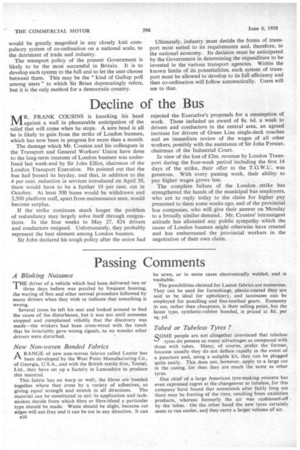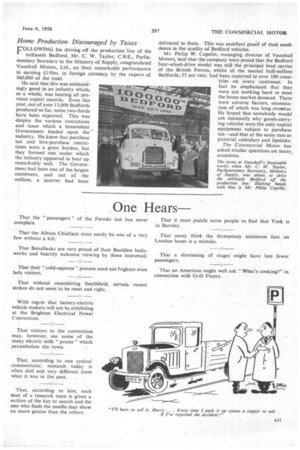Passing Comments
Page 36

Page 37

If you've noticed an error in this article please click here to report it so we can fix it.
A Blinking Nuisance THE driver of a vehicle which had been delivered two or
three days before was puzzled by frequent hooting, the waving of fists and other normal procedure followed by many drivers when they wish to indicate that something is wrong.
Several times he left his seat and looked around to find the cause of the disturbance, but it was not until someone stopped and complained volubly that the discovery was made—the winkers had been cross-wired with the result that he invariably gave wrong signals, so no wonder other drivers were disturbed.
New Non-woven Bonded Fabrics
A RANGE of new non-woven fabrics called Lantor has 1-1 been developed by the West Point Manufacturing Co., of Georgia, U.S.A., and with the British textile firm, Tootal, Ltd., they have set up a factory in Lancashire to produce this material.
This fabric has no warp or weft; the fibres are bonded together where they cross by a variety of adhesives, so giving equal strength and stretch in all directions. The material can be constituted to suit its application and technicians decide from which fibre or fibre-blend a particular type should be made. Waste should be slight, because cut edges will not fray and it can be cut in any direction. It can B30 be sewn, or in some cases electronically welded, and is washable.
The possibilities claimed for Lantor fabrics are numerous. They can be used for furnishings, plastic-coated they are said to be ideal for upholstery, and laminates can be employed for panelling and fine-toothed gears. Economy in use, rather than cheapness, is their selling point, but the latest type, synthetic-rubber bonded, is priced at 8d. per sq. yd.
Tubed or Tubeless Tyres ?
SOME people are not altogether convinced that tubeless
tyres do possess so many advantages as compared with those with tubes. Many, of course, prefer the former, because usually they do not deflate rapidly in the event of a puncture and, using a suitable kit, they can be plugged quite easily. This does not, however, apply to a large cut in the casing, for then they are much the same as other tyres.
One chief of a large American tyre-making concern has even expressed regret at the changeover to tubeless, for this company have found that sometimes after fairly long use there may be fretting of the rims, resulting from oxidation products, whereas formerly the air was cushioned-off by the tubes. On the other hand the new tyres certainly seem to run cooler, and they carry a larger volume of air.
Home Production Discouraged by Taxes
FOLLOWING his driving off the production line of the millionth Bedford, Mr. C. W. Taylor, C.B.E., Parliamentary Secretary to the Ministry of Supply, congratulated Vauxhall Motors, Ltd., on their remarkable performance in earning £150m. in foreign currency by the export. of 360,000 of the total.
He said that this was outstandingly good in an industry which, as a whole, was beating all previous export records. Even this year, out of over 13,000 Bedfords produced so far, some two-thirds have been exported. This was despite the various restrictions and taxes which a benevolent Government loaded upon the industry. He knew that purchase tax and hire-purchase restrictions were a great burden, but they formed one under which the industry appeared to bear up remarkably well. The Government had been one of the largest customers, and out of the million, a quarter had been delivered to them. 'This was excellent proof of their confidence in the quality of Bedford vehicles.
Mr. Philip W. Copelin, managing director of Vauxhall Motors, said that the company were proud that the Bedford four-wheel-drive model was still the principal load carrier of the British Forces, whilst of the second half-million Bedfords; 55 per cent. had been exported to over 100 coun tries on every continent. In fact he emphasized that they were not working hard to meet the home market demand. There were adverse factors, examination of which was long oveodue. He hoped that somebody would ask insistently why goods-carrying vehicles were 'the only capital equipment subject to purchase tax—and that at the same rate as pictorial calendars and lipsticks.
The Commercial Motor has
asked similar questions on many. occasions.








































































































































